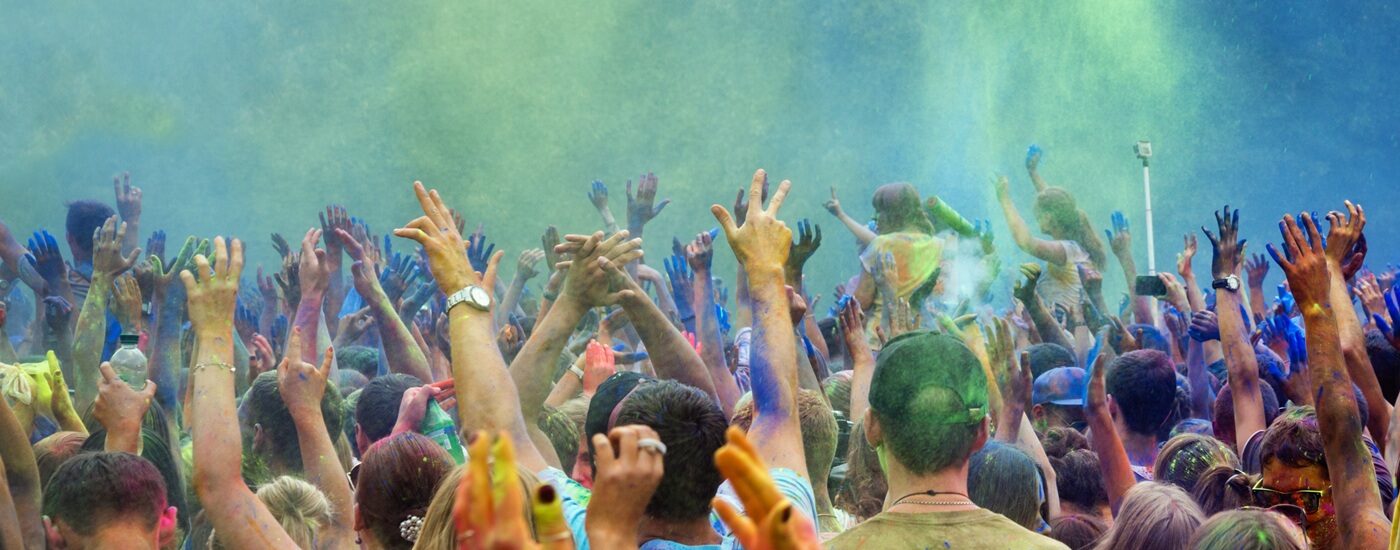Celebrating Culture and Tradition: The 30 Best Festivals in India
Known for its rich cultural heritage, diverse traditions and vibrant celebrations, you’ll find some of the world’s best festivals in India. Throughout the year, various regions across the country come alive with exuberant celebrations, offering a glimpse into the country’s cultural tapestry.
Timing your tour to incorporate a few festivals in India can be a transformative and immersive way to experience the vibrant culture and rich traditions of the country. Whether you find yourself in the snow-capped Himalayas, the bustling cities of North India, the serene backwaters of South India, the cultural hotspots of West and East India, or the heartland of Central India, there is a festival waiting to captivate your senses and create lasting memories.
In this blog post, we will explore the 30 best festivals in India, so you can align your journey for an extraordinary cultural experience.
What to Expect at Festivals in India
Festivals in India are a kaleidoscope of vibrant colours, joyful celebrations, and cultural richness. Each festival has its unique significance and rituals, offering visitors a diverse range of experiences. Prepare to immerse yourself in a flurry of activity, rhythmic music, traditional dances, delicious food, and a strong sense of community spirit.
One of the remarkable aspects of festivals in India is the sheer exuberance and energy that fills the air. From the spirited dances of Garba during Navratri to the awe-inspiring display of fireworks during Diwali, every festival brings a unique fervour and excitement. You can witness the devotion and devotion of the worshippers during religious processions, be captivated by the elaborate decorations and artistic expressions, and feel the warmth of Indian hospitality as locals extend their greetings and offer traditional sweets and delicacies.
What to Wear at Festivals in India
Embracing the vibrant and colourful clothing styles of India will not only make you feel a part of the festivities but also enhance your overall experience. It is worth considering the climate and weather conditions while choosing your festival attire. Light and breathable fabrics like cotton or silk are ideal for hot summer festivals, while warmer fabrics like wool or silk blends are suitable for festivals during colder months. Don’t forget to accessorize with statement jewellery, such as bangles, earrings, or necklaces, which can add a touch of sparkle to your festival ensemble.
The 30 Best Festivals in India
1. Pongal – South India (Mid-January)
Pongal is a four-day harvest festival celebrated predominantly in Tamil Nadu. It is a time when people express gratitude to the Sun God for a bountiful harvest. One of the most famous festivals in India, the celebration involves cooking a special dish called Pongal, drawing colourful Kolam patterns, and participating in traditional games and cultural performances.
Image: Photo by A N Suresh on Unsplash
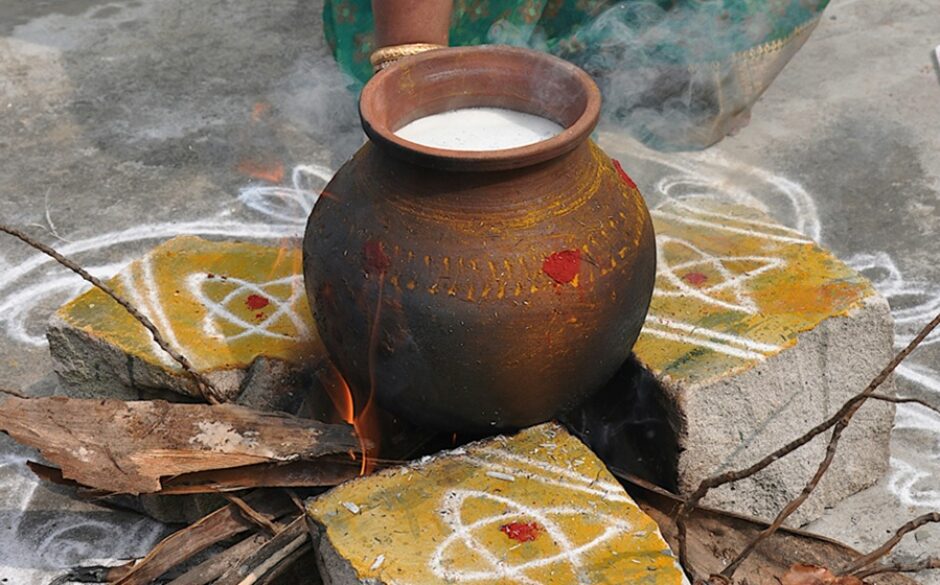
2. Makar Sankranti – Gujarat (January)
Celebrated across India but particularly in Gujarat, Makar Sankranti marks the transition of the sun into the zodiac sign of Capricorn. In Gujarat, people fly colourful kites, participate in kite-flying competitions, enjoy traditional sweets like ‘til chikki’ and ‘undhiyu’, and engage in cultural activities. The sky becomes a spectacle of fluttering kites, creating a joyful atmosphere synonymous with the vibrant festivals in India.
3. Lohri – North India (January)
Lohri is a popular harvest festival celebrated primarily in North India, particularly in Punjab and parts of Himachal Pradesh and Haryana. It marks the end of winter and the arrival of longer days. Bonfires are lit, and people gather around to sing folk songs, perform traditional dances like Bhangra and Gidda, and indulge in festive delicacies like rewri, gajak, and popcorn.
4. The Jaisalmer Desert Festival – Jaisalmer, Rajasthan (January/February)
The Jaisalmer Desert Festival is a three-day extravaganza showcasing Rajasthani culture through folk music, dance performances, camel races, turban-tying competitions, and more. Visitors can try traditional delicacies and explore the vibrant culture of the region against the mesmerising backdrop of the Thar Desert.
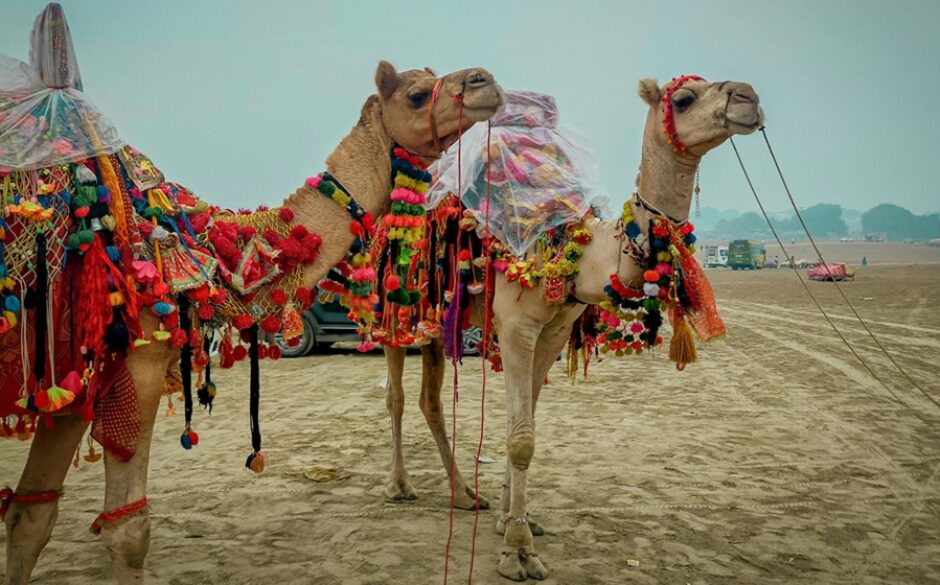
5. Bihu – Assam (January, April, and October)
Bihu is a set of three harvest festivals celebrated in Assam: Magh Bihu (in January), Bohag Bihu (in April) and Kaati Bihu (in October). These festivals mark the agricultural cycles and are a vibrant showcase of Assamese culture. People engage in traditional dances, sing folk songs, exchange traditional sweets, and participate in community feasts. Bihu is a time of joy, camaraderie, and gratitude for the abundance of nature, making it one of the essential festivals in India when it comes to culture.
6. Taj Mahotsav – Golden Triangle (February)
The Taj Mahotsav is a ten-day extravaganza held in Agra, near the iconic Taj Mahal. This cultural festival showcases traditional arts, crafts, music, and dance from various parts of India, making it a true celebration of festivals in India. Visitors can immerse themselves in the artistic heritage of the country and savour delicious regional cuisine, creating a memorable experience.
7. Khajuraho Dance Festival – Central India (February/March)
The Khajuraho Dance Festival, held against the backdrop of the famous Khajuraho temples in Madhya Pradesh, showcases the best of classical dance forms from all over India, embodying the essence of festivals in India. Renowned dancers perform under the starlit sky, highlighting the grace, beauty, and intricacy of Indian classical dance, captivating the hearts of the audience.
8. Goa Carnival – Goa (February/March)
The Goa Carnival, a vibrant and joyous celebration, takes place in the streets of Goa, adding to the mosaic of festivals in India. This Portuguese-influenced festival features colourful parades, floats, live music and dancing. Participants don masks and costumes, creating a lively atmosphere as they revel in the spirit of merriment and festivity, truly embodying the festive spirit of India.
9. Holi – Central India (March)
Holi, the festival of colours, is one of the most famous and beloved festivals in India. It celebrates the arrival of spring and the triumph of good over evil. Participants joyfully play with vibrant coloured powders, engage in water fights, relish festive sweets, and dance to traditional folk music. Holi unites people of all ages, fostering a sense of togetherness and renewal. It is a celebration of life, love, and the enduring spirit of the Indian people.
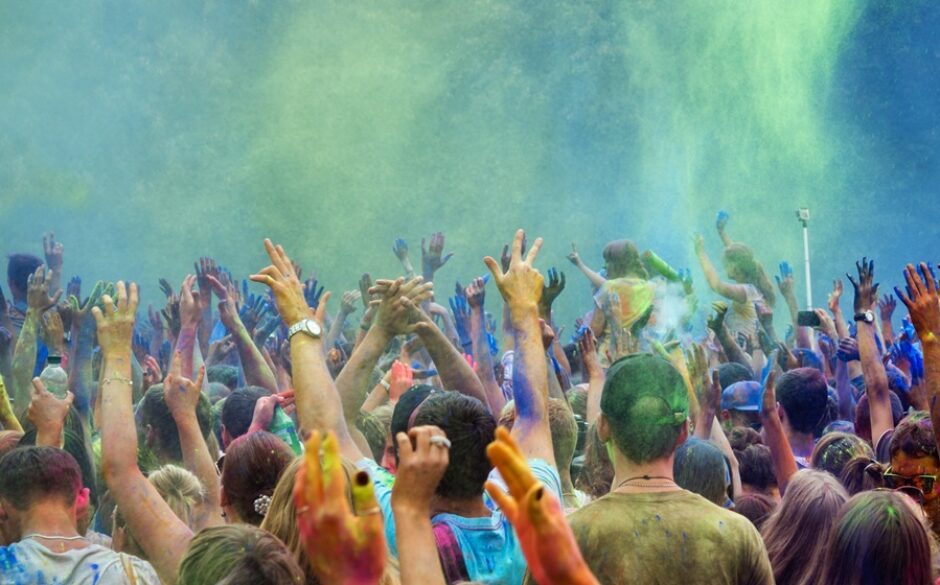
10. Ganguar Festival – Rajasthan(March/April)
Ganguar Festival is a vibrant celebration in Rajasthan, particularly in Jaipur, Udaipur, and Jodhpur and is held straight after Holi. It honours marital bliss and prosperity, as married women dress in colourful attire, carry idols of Goddess Gauri, and partake in lively music, folk dances, and cultural performances.
11. Rongali Bihu – Assam (April)
Rongali Bihu, also called Bohag Bihu, is the most significant festival in Assam, showcasing the lively spirit of Assamese culture and adding to the tapestry of festivals in India. It marks the beginning of the agricultural season and celebrates the Assamese New Year. The festival is accompanied by vibrant folk dances like the Bihu dance, traditional music, feasts, and cultural competitions, creating a dynamic and festive atmosphere for all to enjoy.
12. Baisakhi – North India (April)
Celebrated primarily in Punjab, the harvest festival Baisakhi marks the start of the Sikh New Year and commemorates the formation of the Khalsa Panth. The festivities include vibrant processions, traditional music and dance performances like Bhangra and Gidda, and the celebration is our choice of festivals in India to experience Punjabi hospitality.
13. Thrissur Pooram – Kerala (April/May)
Thrissur Pooram is a grand temple festival held in Thrissur, Kerala. It showcases a captivating display of elephant processions, traditional percussion ensembles, and dazzling fireworks. The festival brings together various temples, creating a vibrant atmosphere filled with devotion and cultural splendour.
14. Buddha Purnima – All over India (May)
Buddha Purnima, also known as Vesak or Buddha Jayanti, commemorates the birth, enlightenment, and death of Gautama Buddha, the founder of Buddhism. Devotees visit Buddhist temples, offer prayers, meditate, and participate in spiritual discourses. The festival is marked by acts of kindness, generosity, and compassion as followers strive to emulate the teachings and virtues of Lord Buddha.
15. Jagannath Rath Yatra – East India (June/July)
Next on our list of festivals in India is the Jagannath Rath Yatra, Held in Puri, Odisha, Jagannath Rath Yatra is a grand chariot festival dedicated to Lord Jagannath. Enthusiastic devotees pull colossal chariots carrying the deities through the streets. The atmosphere is filled with religious enthusiasm, traditional music, dance, and colourful processions.
16. Hemis Festival – Himalayas (June/July)
When it comes to festivals in India in the Himalayas, don’t miss the Hemis Festival, held in Ladakh, Jammu, and Kashmir, the festivities celebrate the birth anniversary of Guru Padmasambhava, the founder of Tibetan Buddhism. This colourful festival features masked dances, traditional music, and vibrant processions. It provides a unique insight into the spiritual traditions of the region.
Image: Arian Zwegers
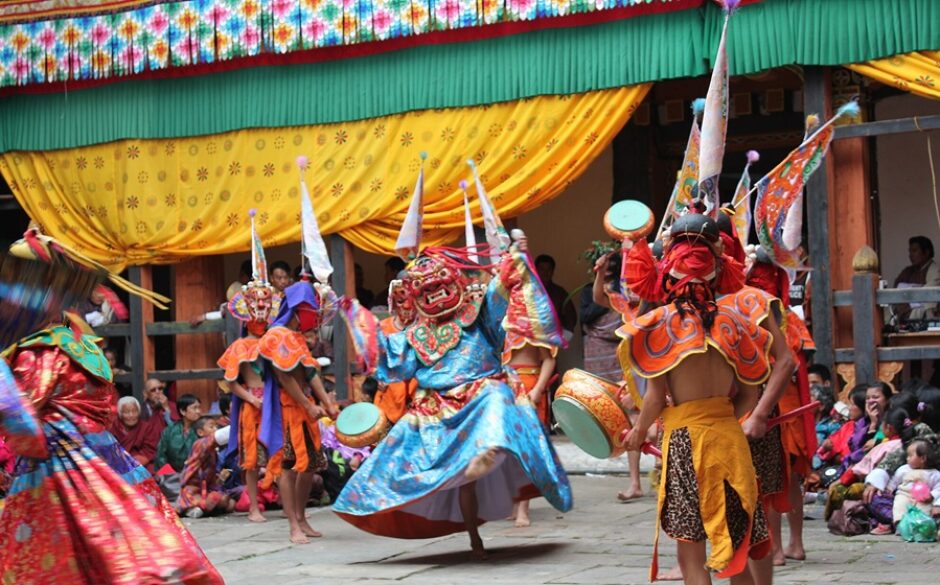
17. Teej Festival – Various states of India, including Rajasthan, Uttar Pradesh, Haryana, Punjab, and parts of Bihar (July/August)
Teej is a vibrant festival celebrated primarily by women in various states of India. Dedicated to the Hindu goddess Parvati, it symbolizes womanhood, marital bliss, and the arrival of the monsoon season. Women observe a fast, dress in colourful attire, apply henna, and engage in folk dances like Ghoomar. This celebration adds to the diverse tapestry of festivals in India, blending devotion, joy, and the spirit of togetherness.
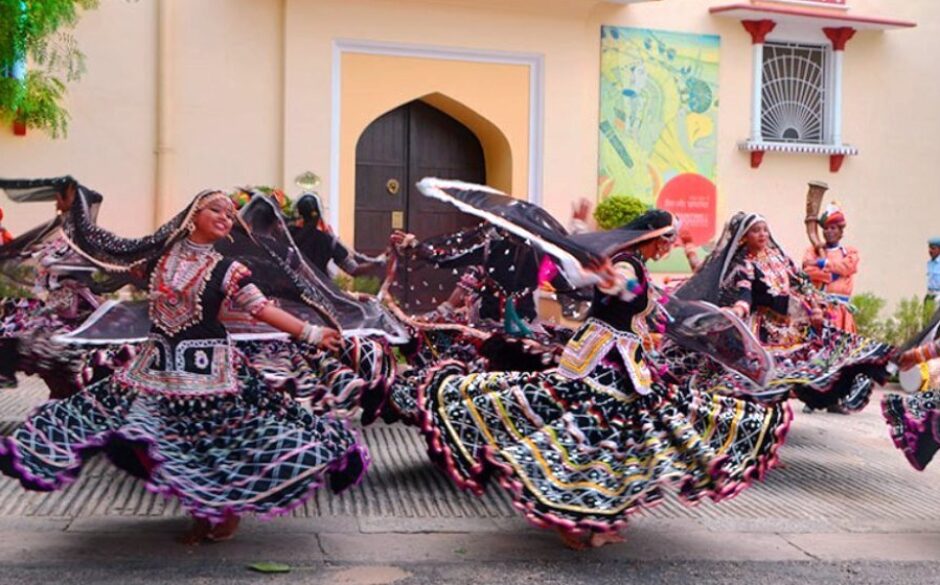
18. Ganesh Chaturthi – West India (August/September)
Ganesh Chaturthi is one of the most vibrant festivals in India dedicated to Lord Ganesha, the elephant-headed deity. It is celebrated with great pomp in Maharashtra and other parts of Western India. The festival involves the installation of Ganesha idols, elaborate processions, devotional singing, and immersion of the idols in water.
19. Snake Boat Festival – Kerala (August/September)
The Snake Boat Festival, also known as the Nehru Trophy Boat Race, takes place in the backwaters of Alleppey, Kerala. This thrilling event features long, narrow boats known as ‘Chundan Vallams’ manned by rowers singing traditional boat songs. The race is a display of incredible teamwork and skill, attracting spectators from far and wide to observe one of the quirkiest festivals in India.
20. Onam – South India (August/September)
Onam, the harvest festival of Kerala, is a ten-day extravaganza filled with colourful cultural programs. It celebrates the homecoming of the mythical King Mahabali. People decorate their homes with floral carpets (Pookalam), indulge in sumptuous feasts (Onasadya), and participate in snake boat races (Vallamkali) and traditional dance forms like Kaikottikali. It’s one of the festivals in India not to be missed if you’re braving a visit to the south in monsoon season.
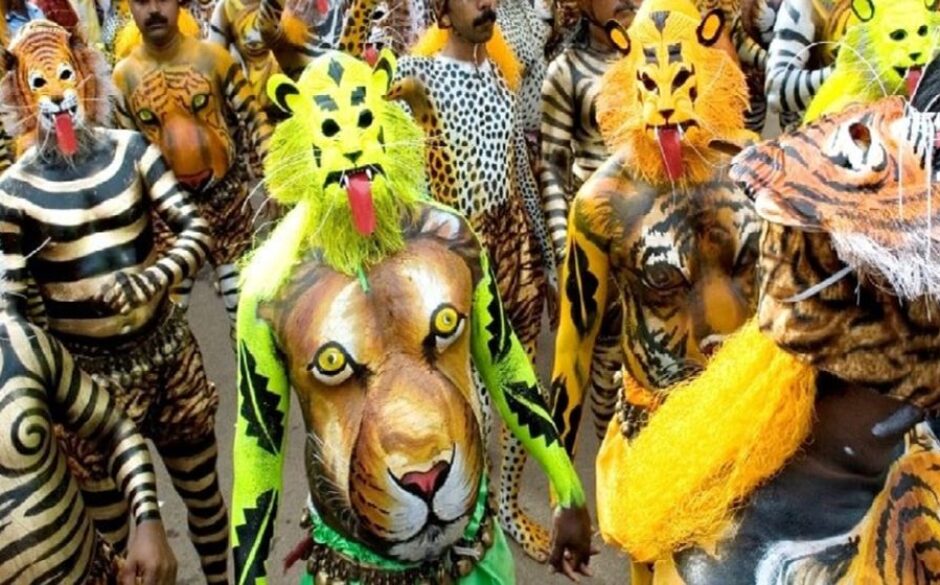
21. Ladakh Festival – Himalayas (September)
The Ladakh Festival showcases the vibrant cultural heritage of the region. Held in Leh, Ladakh, this grand event features traditional music, dance performances, polo matches, archery competitions, and colourful processions. Another of our Himalayan festivals in India, it provides an excellent opportunity to experience the unique culture and breathtaking landscapes of Ladakh.
22. Navratri – West India (September/October)
Navratri, meaning ‘nine nights’, is celebrated with immense joy in Gujarat and other parts of West India, contributing to the vibrant landscape of festivals in India. This festival honours the Hindu goddess Durga and Lord Ram’s victory over Ravana on Dussehra. Energetic Garba and Dandiya-Raas dances are performed by men and women dressed in colourful traditional attire. The rhythmic beats and vibrant movements create an electrifying atmosphere, captivating participants and spectators alike.
23. Durga Puja – East India (September/October)
Another festival in honour of the goddess Durga, but this time in celebration of her victory over the buffalo demon Mahishasura. Durga Puja is the most significant festival in West Bengal and other parts of East India and involves elaborate decorations, artistic idols of the goddess, cultural performances, and the immersion of the idols in rivers or lakes. It is a cherished event during the festivals in India.
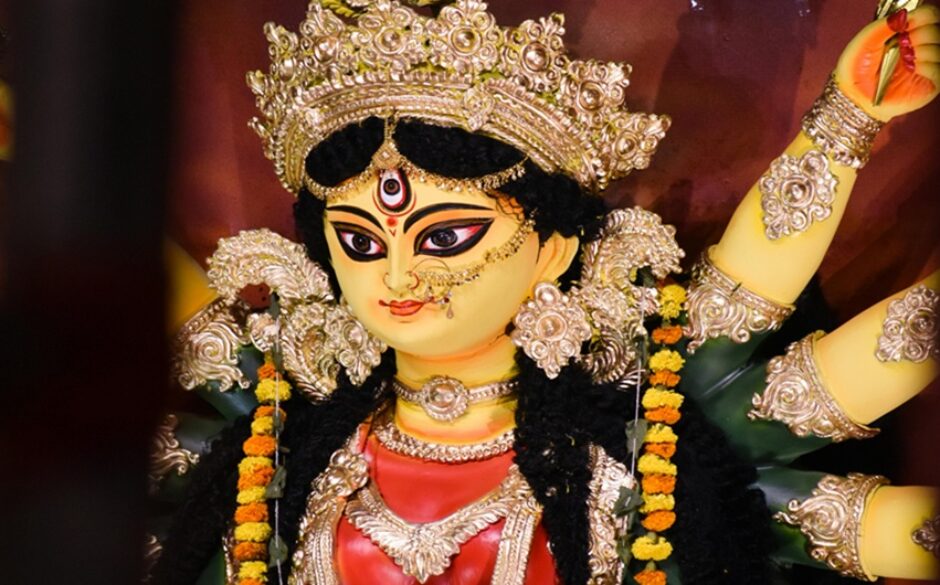
24. Pushkar Camel Fair – West India (October/November)
The Pushkar Camel Fair, held in the holy town of Pushkar in Rajasthan, is a mesmerising spectacle that attracts both locals and tourists. It is the largest camel fair in the world and features camel races, livestock trading, colourful folk performances, and the famous Pushkar Lake pilgrimage.
25. Diwali – Golden Triangle (October/November)
Diwali, the Festival of Lights, is celebrated with immense enthusiasm throughout India. It signifies the triumph of light over darkness and good over evil. The festivities include lighting oil lamps, bursting fireworks, exchanging gifts, and enjoying traditional sweets and delicacies. This is one of the festivals in India not to be missed!
26. Karva Chauth – North India (October/November)
Karva Chauth is a fasting ritual observed by married women in North India, particularly in states like Punjab, Rajasthan, and Uttar Pradesh. Married women observe a day-long fast from sunrise to moonrise for the well-being and longevity of their husbands. They break their fast after sighting the moon and performing prayers. Karva Chauth is a celebration of love, devotion, and the unbreakable bond between partners, adding to the diverse array of festivals in India.
27. Hampi Festival – Hampi, Karnataka (November)
Hampi Festival is a vibrant celebration held in the historical town of Hampi, Karnataka, India. Taking place in the first week of November, this five-day festival brings the glorious history and rich heritage of Hampi to life through music, dance, drama, and cultural performances. The ancient ruins and stunning landscapes of Hampi provide a picturesque backdrop for this grand celebration.
28. Rann Utsav – West India (November/February)
Rann Utsav, held in the Rann of Kutch in Gujarat, showcases the cultural diversity of the region. This vibrant festival offers a platform for artisans, musicians, and performers to exhibit their talents. Visitors can enjoy folk dances, camel rides, traditional handicrafts, and the mesmerising beauty of the white desert.
29. Hornbill Festival – Northeast India (December)
The Hornbill Festival, held in Nagaland, celebrates the rich tribal heritage of Northeast India. This week-long extravaganza showcases the traditional arts, music, dance, and indigenous customs of the various Naga tribes. Visitors can witness colourful performances, explore tribal villages, taste local cuisine, and participate in traditional games and sports.
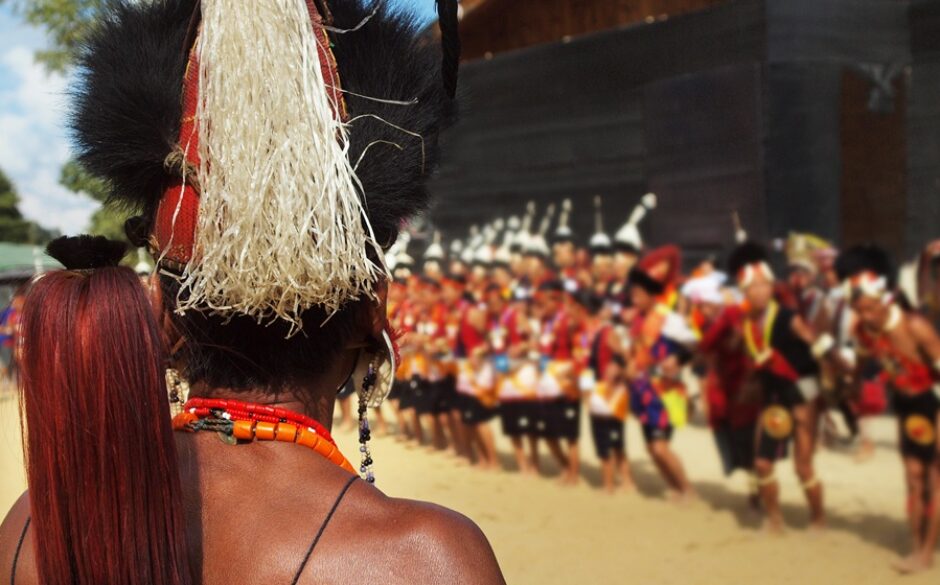
30. Kumbh Mela – North India (January/February, April/May, August/September, and October/November)
The Kumbh Mela is the world’s largest religious gathering, held in rotation between four sacred cities in North India: Prayagraj (formerly Allahabad), Haridwar, Nashik, and Ujjain. Millions of pilgrims gather to take a holy dip in the sacred rivers, seeking spiritual purification. The Kumbh Mela is a vibrant display of faith, with sadhus (holy men), religious ceremonies, cultural performances, and discussions on spiritual topics.
Photo by PANKAJ CHAUHAN: https://www.pexels.com/photo/arial-view-of-kumbh-mela-at-triveni-sangam-30218192/
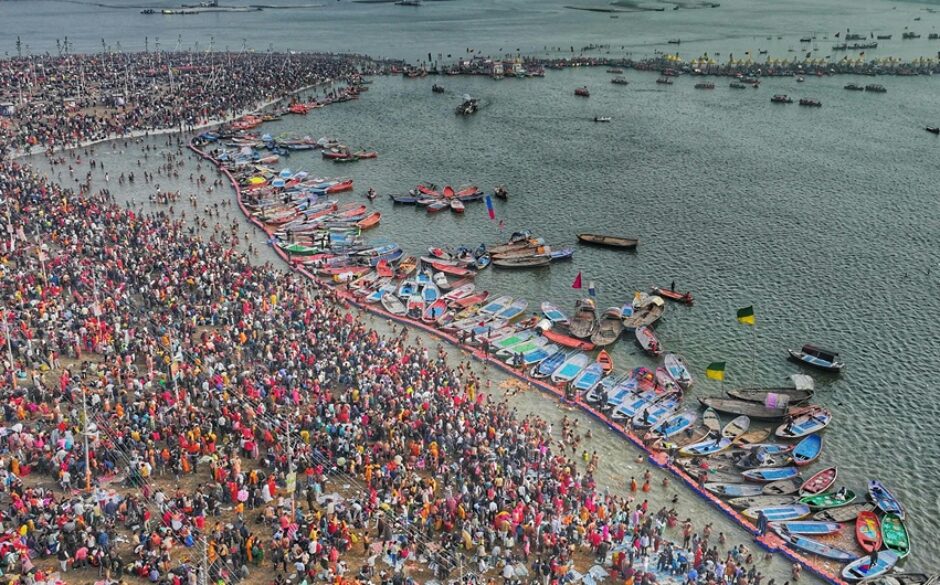
Diverse landscapes and cultural heritage give rise to a myriad of festivals in India, each offering a unique experience.
From the colourful celebrations of North India to the spiritual aura of the Himalayas, from the rich traditions of South India to the vibrant festivities of West India, and from the cultural extravaganza of East India to the heart-warming traditions of Central India, these festivals showcase the country’s cultural tapestry.
Attending festivals in India allows travellers to immerse themselves in the vibrant colours, sounds, and flavours of India, providing an unforgettable experience and a deeper understanding of its diverse cultural heritage.
Why not contact our friendly team to start planning your next tour – including a festival or two?

